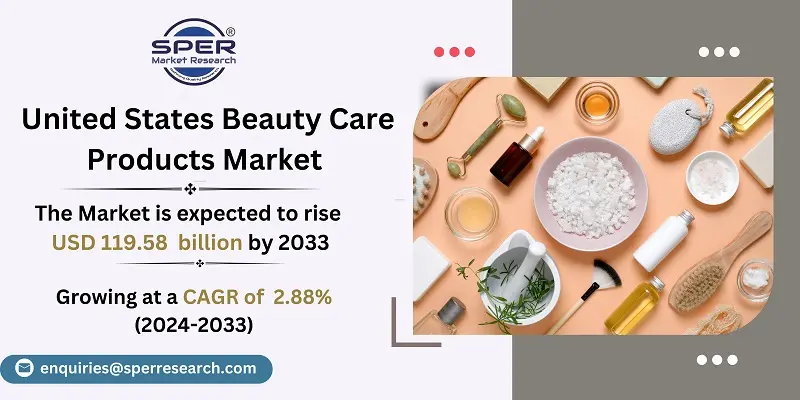
United States Beauty Care Products Market Growth, Size, Trends, Share, Scope and Future Outlook
United States Beauty Care Products Market Size- By Product Type, By Category, By Distribution Channel- Regional Outlook, Competitive Strategies and Segment Forecast to 2033
| Published: May-2024 | Report ID: FMCG24107 | Pages: 1 - 103 | Formats*: |
| Category : Consumer & Retail | |||
- Procter & Gamble Company's Crest brand debuted Crest Densify, a high-end toothpaste that actively restores tooth density by remineralizing enamel, in March 2022. The toothpaste makes the promise that it will fortify teeth and shield them from further decay.
- February 2022: In order to bolster its line of luxury skincare products, Beiersdorf successfully acquired Chantecaille Beauté Inc., a well-known prestige cosmetics brand in the US.


| Report Metric | Details |
| Market size available for years | 2020-2033 |
| Base year considered | 2023 |
| Forecast period | 2024-2033 |
| Segments covered | By Product Type, By Category, By Distribution Channel |
| Regions covered | Eastern, Western, Northern, Southern |
| Companies Covered | Alticor (Amway Corp.), Colgate-Palmolive Company, Johnson & Johnson Services, Inc., L'Oréal S.A., maxingvest AG (Beiersdorf AG), Natura & Co, Procter & Gamble Company, Revlon Inc., Shiseido Company Limited, The Estée Lauder Companies Inc., Unilever PLC, Others |
- Elderly Population
- Ethnic and Cultural Groups
- Health and Wellness Enthusiasts
- Individuals with Specific Skin Conditions
- Men's Grooming
- Professionals in the Beauty Industry
- Teenagers and Young Adults
- Women of All Ages
- Others
| By Product Type: |
|
| By Category: |
|
| By Distribution Channel: |
|
- United States Beauty Care Products Market Size (FY’2024-FY’2033)
- Overview of United States Beauty Care Products Market
- Segmentation of United States Beauty Care Products Market By Product Type (Personal Care, Skin Care, Bath and Shower, Oral Car, Men’s Grooming, Deodrants and Antiperspirants, Beauty and Make-up/Cosmetics, Color Cosmetics)
- Segmentation of United States Beauty Care Products Market By Category (Premium Products, Mass Products)
- Segmentation of United States Beauty Care Products Market By Distribution Channel (Supermarkets/Hypermarkets, Convenience Stores, Online Retail Stores, Pharmacies
- Specialist Retail Stores)
- Expansion Analysis of United States Beauty Care Products Market
- Problems and Obstacles in United States Beauty Care Products Market
- Competitive Landscape in the United States Beauty Care Products Market
- Impact of COVID-19 and Demonetization on United States Beauty Care Products Market
- Details on Current Investment in United States Beauty Care Products Market
- Competitive Analysis of United States Beauty Care Products Market
- Prominent Players in the United States Beauty Care Products Market
- SWOT Analysis of United States Beauty Care Products Market
- United States Beauty Care Products Market Future Outlook and Projections (FY’2024-FY’2033)
- Recommendations from Analyst
1.1. Scope of the report1.2. Market segment analysis
2.1. Research data source2.1.1. Secondary Data2.1.2. Primary Data2.1.3. SPER’s internal database2.1.4. Premium insight from KOL’s2.2. Market size estimation2.2.1. Top-down and Bottom-up approach2.3. Data triangulation
4.1. Driver, Restraint, Opportunity and Challenges analysis4.1.1. Drivers4.1.2. Restraints4.1.3. Opportunities4.1.4. Challenges4.2. COVID-19 Impacts of the United States Beauty Care Products Market
5.1. SWOT Analysis5.1.1. Strengths5.1.2. Weaknesses5.1.3. Opportunities5.1.4. Threats5.2. PESTEL Analysis5.2.1. Political Landscape5.2.2. Economic Landscape5.2.3. Social Landscape5.2.4. Technological Landscape5.2.5. Environmental Landscape5.2.6. Legal Landscape5.3. PORTER’s Five Forces5.3.1. Bargaining power of suppliers5.3.2. Bargaining power of buyers5.3.3. Threat of Substitute5.3.4. Threat of new entrant5.3.5. Competitive rivalry5.4. Heat Map Analysis
6.1. United States Beauty Care Products Market Manufacturing Base Distribution, Sales Area, Product Type6.2. Mergers & Acquisitions, Partnerships, Product Launch, and Collaboration in United States Beauty Care Products Market
7.1. United States Beauty Care Products Market Size, Share and Forecast, By Product Type, 2020-20267.2. United States Beauty Care Products Market Size, Share and Forecast, By Product Type, 2027-20337.3. Personal Care7.3.1. Hair Care7.3.2. Shampoo7.3.3. Conditioner7.3.4. Hair Oil7.3.5. Hair Styling and Coloring Products7.3.6. Others7.3.7. Skin Care7.3.8. Facial Care7.3.9. Body Care7.3.10. Lip Care7.3.11. Bath and Shower7.3.12. Soaps7.3.13. Shower Gels7.3.14. Bath Salts7.3.15. Bathing Accessories7.3.16. Others
7.3.17. Oral Care
7.3.18. Toothbrushes and Replacements7.3.19. Toothpastes7.3.20. Mouthwashes and Rinses7.3.21. Men’s Grooming7.3.22. Deodrants and Antiperspirants7.4. Beauty and Make-up/Cosmetics Market7.4.1. Color Cosmetics7.4.2. Facial Make-up Products7.4.3. Lip and Nail Makeup-up Products
8.1. United States Beauty Care Products Market Size, Share and Forecast, By Category, 2020-20268.2. United States Beauty Care Products Market Size, Share and Forecast, By Category, 2027-20338.3. Premium Products8.4. Mass Products
9.1. United States Beauty Care Products Market Size, Share and Forecast, By Distribution Channel, 2020-20269.2. United States Beauty Care Products Market Size, Share and Forecast, By Distribution Channel, 2027-20339.3. Supermarkets/Hypermarkets9.4. Convenience Stores9.5. Online Retail Stores9.6. Pharmacies
9.7. Specialist Retail Stores
10.1. United States Beauty Care Products Market Size and Market Share
11.1. United States Beauty Care Products Market Size and Market Share By Region (2020-2026)11.2. United States Beauty Care Products Market Size and Market Share By Region (2027-2033)11.3. Eastern11.4. Western11.5. Northern11.6. Southern
12.1. Alticor (Amway Corp.)12.1.1. Company details12.1.2. Financial outlook12.1.3. Product summary12.1.4. Recent developments12.2. Colgate-Palmolive Company12.2.1. Company details12.2.2. Financial outlook12.2.3. Product summary12.2.4. Recent developments12.3. Johnson & Johnson Services, Inc.12.3.1. Company details12.3.2. Financial outlook12.3.3. Product summary12.3.4. Recent developments12.4. L'Oréal S.A.12.4.1. Company details12.4.2. Financial outlook12.4.3. Product summary12.4.4. Recent developments12.5. maxingvest AG (Beiersdorf AG)12.5.1. Company details12.5.2. Financial outlook12.5.3. Product summary12.5.4. Recent developments12.6. Natura & Co12.6.1. Company details12.6.2. Financial outlook12.6.3. Product summary12.6.4. Recent developments12.7. Procter & Gamble Company12.7.1. Company details12.7.2. Financial outlook12.7.3. Product summary12.7.4. Recent developments12.8. Revlon Inc.12.8.1. Company details12.8.2. Financial outlook12.8.3. Product summary12.8.4. Recent developments12.9. Shiseido Company Limited12.9.1. Company details12.9.2. Financial outlook12.9.3. Product summary12.9.4. Recent developments12.10. The Estée Lauder Companies Inc.12.10.1. Company details12.10.2. Financial outlook12.10.3. Product summary12.10.4. Recent developments12.11. Unilever PLC12.11.1. Company details12.11.2. Financial outlook12.11.3. Product summary12.11.4. Recent developments12.12. Others
SPER Market Research’s methodology uses great emphasis on primary research to ensure that the market intelligence insights are up to date, reliable and accurate. Primary interviews are done with players involved in each phase of a supply chain to analyze the market forecasting. The secondary research method is used to help you fully understand how the future markets and the spending patterns look likes.
The report is based on in-depth qualitative and quantitative analysis of the Product Market. The quantitative analysis involves the application of various projection and sampling techniques. The qualitative analysis involves primary interviews, surveys, and vendor briefings. The data gathered as a result of these processes are validated through experts opinion. Our research methodology entails an ideal mixture of primary and secondary initiatives.



Frequently Asked Questions About This Report
PLACE AN ORDER
Year End Discount
Sample Report
Pre-Purchase Inquiry
NEED CUSTOMIZATION?
Request CustomizationCALL OR EMAIL US
100% Secure Payment






Related Reports
Our Global Clients
Our data-driven insights have influenced the strategy of 200+ reputed companies across the globe.




















